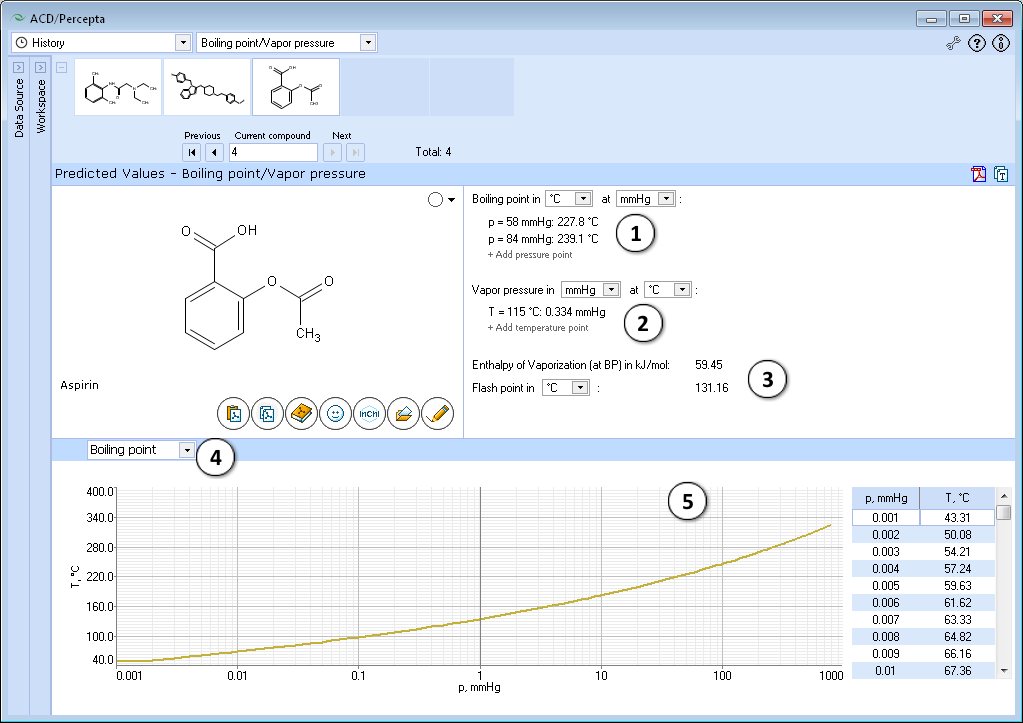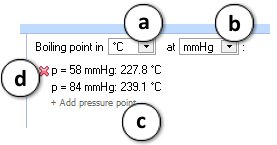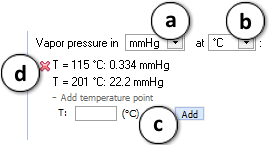Boiling Point/Vapor Pressure: Difference between revisions
Jump to navigation
Jump to search
No edit summary |
|||
| Line 20: | Line 20: | ||
:a. Select one of the available temperature units<br><br> | :a. Select one of the available temperature units<br><br> | ||
:b. Choose pressure measurement units from the drop-down list<br><br> | :b. Choose pressure measurement units from the drop-down list<br><br> | ||
c. Click "+/-" nodes to expand/collapse the option of the new system pressure value addition for which the boiling point should be calculated. Enter desirable pressure value and press "Add". The new pressure value along with automatically calculated boiling point will appear at the end of the list.<br><br> | |||
:d. Hover over the | :d. Hover over the particular pressure entry and press the "x" pictogram to remove it from the list.</li><br> | ||
<li>Prediction of the saturated vapor pressure of the query compound in the closed equilibrium system at the user-defined temperature.<br><br> | <li>Prediction of the saturated vapor pressure of the query compound in the closed equilibrium system at the user-defined temperature.<br><br> | ||
:[[File:add_temperature_point.png|left]]a. Choose pressure measurement units from the drop-down list<br><br> | :[[File:add_temperature_point.png|left]]a. Choose pressure measurement units from the drop-down list<br><br> | ||
:b. Select one of the available temperature units.<br><br> | :b. Select one of the available temperature units.<br><br> | ||
:c. Click "+/-" nodes to expand/collapse the option of the new temperature point addition for which the vapor pressure should be calculated. Enter desirable temperature value and press "Add". The new saturated | :c. Click "+/-" nodes to expand/collapse the option of the new temperature point addition for which the vapor pressure should be calculated. Enter desirable temperature value and press "Add". The new saturated temperature point along with automatically calculated vapor pressure will appear at the end of the list.<br><br> | ||
:d. Hover over the | :d. Hover over the he particular temparature entry and press the "x" pictogram to remove it from the list.</li><br> | ||
<li>Switch between the 'Boiling point' and 'Vapor pressure' graphs.</li><br> | <li>Switch between the 'Boiling point' and 'Vapor pressure' graphs.</li><br> | ||
<li>The respective 'Boiling point vs pressure' or 'Vapor pressure vs temperature' dependences are visualized in the form of a graph and a supplementary table.<br> | <li>The respective 'Boiling point vs pressure' or 'Vapor pressure vs temperature' dependences are visualized in the form of a graph and a supplementary table.<br> | ||
Revision as of 13:31, 18 March 2013
Overview
The module provides an estimate of the main physical constants characterizing the transition of the substance from liquid into the gaseous state (boiling point, vapor pressure and enthalpy of vaporization). Multiple choices of temperature scales and pressure units are available for the description of the environmental conditions for which the calculations should be performed.
Features
- Estimate the boiling point of organic compounds as a function of pressure
- Estimate the vapor pressure as a function of temperature
- View the above mentioned dependences in graphical or tabular form
Interface
- Calculated boiling point value at specified pressure and converted to the selected temperature scale:
- a. Select one of the available temperature units
- b. Choose pressure measurement units from the drop-down list
c. Click "+/-" nodes to expand/collapse the option of the new system pressure value addition for which the boiling point should be calculated. Enter desirable pressure value and press "Add". The new pressure value along with automatically calculated boiling point will appear at the end of the list.
- d. Hover over the particular pressure entry and press the "x" pictogram to remove it from the list.
- a. Select one of the available temperature units
- Prediction of the saturated vapor pressure of the query compound in the closed equilibrium system at the user-defined temperature.
- a. Choose pressure measurement units from the drop-down list
- b. Select one of the available temperature units.
- c. Click "+/-" nodes to expand/collapse the option of the new temperature point addition for which the vapor pressure should be calculated. Enter desirable temperature value and press "Add". The new saturated temperature point along with automatically calculated vapor pressure will appear at the end of the list.
- d. Hover over the he particular temparature entry and press the "x" pictogram to remove it from the list.
- a. Choose pressure measurement units from the drop-down list
- Switch between the 'Boiling point' and 'Vapor pressure' graphs.
- The respective 'Boiling point vs pressure' or 'Vapor pressure vs temperature' dependences are visualized in the form of a graph and a supplementary table.

- a. Click and drag the slider to focus on the appropriate table row and see the calculated property value at relevant conditions.
- b. Alternatively, click on a table row to automatically move the slider to highlight the position of the specific point on the graph.
- a. Click and drag the slider to focus on the appropriate table row and see the calculated property value at relevant conditions.


